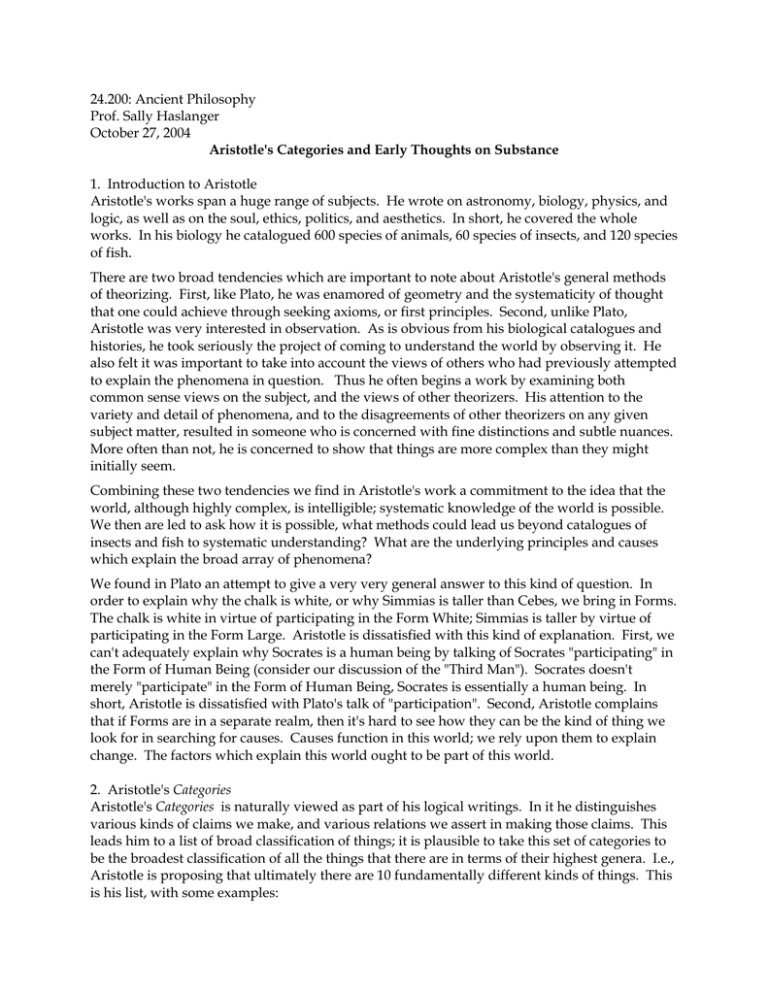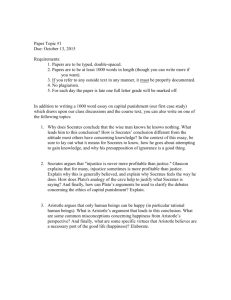24.200: Ancient Philosophy Prof. Sally Haslanger October 27, 2004
advertisement

24.200: Ancient Philosophy Prof. Sally Haslanger October 27, 2004 Aristotle's Categories and Early Thoughts on Substance 1. Introduction to Aristotle Aristotle's works span a huge range of subjects. He wrote on astronomy, biology, physics, and logic, as well as on the soul, ethics, politics, and aesthetics. In short, he covered the whole works. In his biology he catalogued 600 species of animals, 60 species of insects, and 120 species of fish. There are two broad tendencies which are important to note about Aristotle's general methods of theorizing. First, like Plato, he was enamored of geometry and the systematicity of thought that one could achieve through seeking axioms, or first principles. Second, unlike Plato, Aristotle was very interested in observation. As is obvious from his biological catalogues and histories, he took seriously the project of coming to understand the world by observing it. He also felt it was important to take into account the views of others who had previously attempted to explain the phenomena in question. Thus he often begins a work by examining both common sense views on the subject, and the views of other theorizers. His attention to the variety and detail of phenomena, and to the disagreements of other theorizers on any given subject matter, resulted in someone who is concerned with fine distinctions and subtle nuances. More often than not, he is concerned to show that things are more complex than they might initially seem. Combining these two tendencies we find in Aristotle's work a commitment to the idea that the world, although highly complex, is intelligible; systematic knowledge of the world is possible. We then are led to ask how it is possible, what methods could lead us beyond catalogues of insects and fish to systematic understanding? What are the underlying principles and causes which explain the broad array of phenomena? We found in Plato an attempt to give a very very general answer to this kind of question. In order to explain why the chalk is white, or why Simmias is taller than Cebes, we bring in Forms. The chalk is white in virtue of participating in the Form White; Simmias is taller by virtue of participating in the Form Large. Aristotle is dissatisfied with this kind of explanation. First, we can't adequately explain why Socrates is a human being by talking of Socrates "participating" in the Form of Human Being (consider our discussion of the "Third Man"). Socrates doesn't merely "participate" in the Form of Human Being, Socrates is essentially a human being. In short, Aristotle is dissatisfied with Plato's talk of "participation". Second, Aristotle complains that if Forms are in a separate realm, then it's hard to see how they can be the kind of thing we look for in searching for causes. Causes function in this world; we rely upon them to explain change. The factors which explain this world ought to be part of this world. 2. Aristotle's Categories Aristotle's Categories is naturally viewed as part of his logical writings. In it he distinguishes various kinds of claims we make, and various relations we assert in making those claims. This leads him to a list of broad classification of things; it is plausible to take this set of categories to be the broadest classification of all the things that there are in terms of their highest genera. I.e., Aristotle is proposing that ultimately there are 10 fundamentally different kinds of things. This is his list, with some examples: substance: Socrates, human being, animal quality: pale, square, grammatical quantity: 6 ft. tall, 12 inches long relation: half, larger where: in the marketplace when: tomorrow, in October position: is lying, is sitting having: has shoes on doing: cutting, hitting being affected: being cut, being hit Overlaying this classification of things, there is a further fourfold distinction which relies on a distinction between two kinds of predication: being said of, and being present in. Animal is "said of" Socrates (think of this in terms of essential predication -- Socrates could not cease to be an animal and continue to exist); Pale is "present in" Socrates (think of this in terms of accidental predication -- Socrates could cease to be pale and continue to exist). This is the fourfold classification which further divides the items in the 10 categories: a) what is both said of and present in things (non-substance species and genera) b) what is said of but not present in things (species and genera of substance) c) what is present in but not said of things (non-substance individuals) d) what is neither present in nor said of things. (individual substances) In addition to classifying the things that exist, Aristotle is concerned to ask whether there are some sorts of things which should have a privileged status in our theorizing. Are there some sorts of things which are more significant than others, e.g., some sorts of things which are ontologically or epistemologically basic? We can rephrase this question more simply by dividing it into two issues: Are there some sorts of things on which the existence of everything else depends, i.e., things such that if they failed to exist, nothing else would exist? Are there some sorts of things which are required for systematic understanding of the world, i.e., things such that if they failed to exist we couldn't have such knowledge? In the Categories, Aristotle claims that substantial individuals such as Socrates are such privileged items; they are the primary substances. We will find that Aristotle revises this choice by the time he writes the Metaphysics. However, Aristotle's view in the Categories that primary substances are ordinary concrete individuals depended on his acceptance of what we called the subject criterion. I.e., primary substances are the primary logical subjects, i.e., they are that in which properties (qualities, quantities, etc.) inhere, and which are themselves the members of kinds (species). "A substance --that which is called a substance most strictly, primarily, and most of all-- is that which is neither said of a subject nor in a subject." (Cat. 2a11, see also 2a34-2b7) Primary substances are also the subjects of change: "It seems most distinctive of substance that what is numerically one and the same is able to receive contraries [i.e., contrary properties]." (Cat. 4a10) (E.g., a single individual may become hot, having been cold, or may change from being 5' tall to being 5'2" tall.) 3. Physics I In his discussion of change in Physics I: 7-9, Aristotle feels the need to accommodate both the demand that in any change something remain through that change, and the demand that there be something "new" as a product of the change. (See, e.g., the puzzle articulated at 191a25-30). To handle these demands, he distinguishes three "elements" in any change: the matter, the form, the lack. The matter is what persists through the change as subject for the change. The form is what the matter/subject comes to be (i.e., the quality it comes to have, etc.). The lack is what the form replaces. For example, in the case of Socrates turning tan, Socrates is the matter for the change; tanness is the form; not-tan (or pale) is the lack which is replaced by tanness in the change. In the case of the generation of a bronze statue, the bronze is the matter for the change (it is what persists as subject for the form of the statue). The "form" is the statue-shape which is produced. The "lack" is what the bronze loses (the lumpishness?) when it comes to have the shape of the statue. In some cases the "lack" and the "form" will have no name. In addition to the simple elements of a change, viz., the matter, lack, and form, these "elements" make up composites or complexes. Before the change there is a complex of [matter + lack]; after the change there is a "new" complex of [matter + form]. On this schematic model we can see that in any change there is always (a) something which "goes out of existence", (b) something which "comes into existence", as well as (c) something which continues to exist. The composite of [matter + lack] goes out of existence; the composite of [matter + form] comes into existence; the matter remains. It is very important to note that what counts as matter, lack, and form is relative to the change one is considering. In the case of Socrates turning tan, tan is the form, not-tan (pale) is the lack. In the case of Socrates turning pale, pale is the form and not-pale (tan) is the lack. In both of these cases Socrates is the matter for the change. In the case of Socrates dying, Socrates' body is the matter for the change, since the body is what persists through his death. Socrates himself is the composite of body and soul which gives way to a new composite, the corpse. (Presumably the form present in the corpse has no name). Within this general model of change, we can distinguish two kinds of change: alteration, and generation/destruction. Intuitively, when an object alters, the object which changes continues to exist while gaining or losing a property (think of Socrates becoming tan). In contrast, when an object is destroyed, it doesn't merely lose a property, it goes out of existence altogether (think of Socrates dying). We can accommodate this intuitive contrast within Aristotle's account by noting that alterations are cases in which the "matter" for the change is an individual substance, and the "lack" and "form" are merely qualities, quantities, etc., of the substance. I.e., alterations are changes in an object's accidental properties. In the case of generation and destruction, we are considering a composite thing prior to the change, which is replaced by a new composite, i.e., the original [matter + lack] ceases to exist and is replaced by a new [matter + form]. An individual substance such as Socrates will be generated just in case the "form" of the new composite is a substantial form, e.g., the essence or nature of human being (which is human soul). An individual substance will be destroyed just in case the "lack" which is lost is a substantial form. So when Socrates dies, the body ceases to be informed by the soul, and Socrates (the composite of body and soul) ceases to exist. Now that we have introduced the form/matter account of change, should we continue to say that individuals such as Socrates are primary substances? What is the subject of change, i.e., that which persists while gaining and losing properties? What is that in which properties inhere? We'll find that by the time Aristotle writes the Metaphysics he has changed his view 3 about what counts as a primary substance: Individuals such as Socrates no longer qualify. 4







